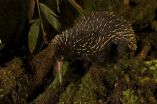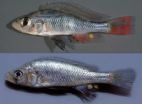(Press-News.org) PITTSBURGH, Jan. 2, 2013 – The presence of a certain molecule allows the immune system to effectively police tuberculosis (TB) of the lungs and prevent it from turning into an active and deadly infection, according to a new study led by researchers at Children's Hospital of Pittsburgh of UPMC and the University of Pittsburgh School of Medicine. Their findings appear today in the online version of the Journal of Clinical Investigation.
More than 2 billion people or one-third of the world's population are infected with mycobacterium tuberculosis, the bacterium that causes TB, said senior author Shabaana A. Khader, Ph.D., assistant professor of pediatrics, Pitt School of Medicine. The infection is challenging to treat partly because the bacillus is able to enter cells and linger for years without causing symptoms, known as latent TB. Then, typically when the immune system becomes impaired due to other reasons such as age or HIV, the infection becomes active and causes the cough, night sweats, fever and weight loss that characterize the disease.
"A hallmark of TB that we see on chest X-rays is the granuloma, a collection of immune cells that surround the infected lung cells," Dr. Khader said. "But what we didn't know was the difference between a functioning protective granulomae, as in latent TB, and a non-protective granuloma seen in active TB patients. We aimed to find immunologic markers that could show us the status of the infection."
For the study, which was funded by the National Institutes of Health, the researchers studied human TB-infected cells as well animal models of the disease. They found that granulomas that contain ectopic lymphoid structures, which resemble lymph nodes, are associated with effective suppression of TB, and that granulomas that don't contain them are associated with active TB. They also learned that immune cells called T cells that had a surface marker molecule called CXCR5 were associated with the presence of ectopic lymphoid structures.
It's akin to reporting a break-in, Dr. Khader said. If a person calls 911 because of a robbery, but doesn't give a specific address, the immune system police could come to the neighborhood but don't know for certain which home was invaded.
"The presence of CXCR5 provides a specific address for the infected cells that tells the immune cells where to focus their attention to contain the problem," she explained. "That results in the formation of ectopic lymphoid structures and the protective granuloma that keeps TB infection under control, unlike in active disease. Without CXCR5, those structures did not form and active TB was more likely."
When the researchers delivered CXCR5 T cells from donor animals to TB-infected mice that lacked CXCR5, T cell localization and ectopic lymphoid structure formation was restored, leading to decreased susceptibility to TB.
"The protective power of CXCR5 points us in a novel direction for future management of TB," Dr. Khader said. "These findings have powerful implications for the development of vaccines to prevent infection."
###
Co-authors include other researchers from the University of Pittsburgh School of Medicine and Children's Hospital of Pittsburgh of UPMC; the University of Rochester Medical Center; Tulane National Primate Research Center; Instituto Nacional de Enfermedades Respiratorias "Ismael Cosio Villegas," Mexico; "National Institute of Psychiatry "Ramon de la Fuente," Mexico; and The American British Cowdray Medical Center, Mexico.
The study was funded NIH grants AI083541, HL105427, RR026006, AI091457, RR020159, RR000164, HL69409, AI060422, and AI91036 as well as Children's Hospital of Pittsburgh of UPMC.
About Children's Hospital of Pittsburgh of UPMC
Renowned for its outstanding clinical services, research programs and medical education, Children's Hospital of Pittsburgh of UPMC has helped establish the standards of excellence in pediatric care. From ambulatory care to transplantation and cardiac care, talented and committed pediatric experts care for infants, children and adolescents who make more than 1 million visits to Children's and its many neighborhood locations each year. Children's also has been named consistently to several elite lists of pediatric health care facilities, including ranking 7th among children's hospitals and schools of medicine (FY 2011) in funding provided by the National Institutes of Health, and is one of 12 pediatric hospitals in the United States named to U.S. News & World Report's Honor Roll of America's "Best Children's Hospitals" for 2012-2013.
About the University of Pittsburgh School of Medicine
As one of the nation's leading academic centers for biomedical research, the University of Pittsburgh School of Medicine integrates advanced technology with basic science across a broad range of disciplines in a continuous quest to harness the power of new knowledge and improve the human condition. Driven mainly by the School of Medicine and its affiliates, Pitt has ranked among the top 10 recipients of funding from the National Institutes of Health since 1998. In rankings recently released by the National Science Foundation, Pitt ranked fifth among all American universities in total federal science and engineering research and development support.
Likewise, the School of Medicine is equally committed to advancing the quality and strength of its medical and graduate education programs, for which it is recognized as an innovative leader, and to training highly skilled, compassionate clinicians and creative scientists well-equipped to engage in world-class research. The School of Medicine is the academic partner of UPMC, which has collaborated with the University to raise the standard of medical excellence in Pittsburgh and to position health care as a driving force behind the region's economy. For more information about the School of Medicine, see www.medschool.pitt.edu.
http://www.upmc.com/media
Contact: Anita Srikameswaran
Phone: 412-578-9193
E-mail: SrikamAV@upmc.edu
Contact: Andrea Kunicky
Phone: 412-692-6254
E-mail: andrea.kunicky@chp.edu
END
Medical centers that elect to keep psychiatric files private and separate from the rest of a person's medical record may be doing their patients a disservice, a Johns Hopkins study concludes.
In a survey of psychiatry departments at 18 of the top American hospitals as ranked by U.S. News & World Report's Best Hospitals in 2007, a Johns Hopkins team learned that fewer than half of the hospitals had all inpatient psychiatric records in their electronic medical record systems and that fewer than 25 percent gave non-psychiatrists full access to those records.
Strikingly, ...
Certain plants and animals protect themselves against temperatures below freezing with antifreeze proteins. How the larva of the beetle Dendroides canadensis manages to withstand temperatures down to -30 degrees Celsius is reported by an international team of researchers led by Prof. Dr. Martina Havenith from the Department of Physical Chemistry II at the Ruhr-Universität in the journal PNAS. Together with American colleagues, the RUB-researchers showed that interactions between the antifreeze proteins and water molecules contribute significantly to protection against the ...
Magnets have practically become everyday objects. Earlier on, however, the universe consisted only of nonmagnetic elements and particles. Just how the magnetic forces came into existence has been researched by Prof. Dr. Reinhard Schlickeiser at the Institute of Theoretical Physics of the Ruhr-Universität Bochum. In the journal Physical Review Letters, he describes a new mechanism for the magnetisation of the universe even before the emergence of the first stars.
No permanent magnets in the early universe
Before the formation of the first stars, the luminous matter consisted ...
Elementary school students often learn that plants grow toward the light. This seems straightforward, but in reality, the genes and pathways that allow plants to grow and move in response to their environment are not fully understood. Leading plant scientists explore one of the most fundamental processes in plant biology—plant movement in response to light, water, and gravity—in a January Special Issue of the American Journal of Botany.
Plant movements, known as tropisms, are crucial for plant survival from the second a plant germinates to how a plant positions its flowers ...
The western long-beaked echidna, one of the world's five egg-laying species of mammal, became extinct in Australia thousands of years ago…or did it? Smithsonian scientists and colleagues have found evidence suggesting that not only did these animals survive in Australia far longer than previously thought, but that they may very well still exist in parts of the country today. The team's findings are published in the Dec. 28, 2012 issue of the journal ZooKeys.
With a small and declining population confined to the Indonesian portion of the island of New Guinea, the western ...
Two new species of cichlid fish from Lake Victoria are described by biologists from Naturalis Biodiversity Center (Research Department Marine Zoology) and the Institute of Biology Leiden (Section Integrative Zoology), the Netherlands. One of these species is named in honour of Tijs Goldschmidt, author of Darwin's Dreampond. This book, published in nine languages, describes the dramatic extinction of hundreds of cichlid species in Lake Victoria in the 1980s due to the introduced Nile perch and other human induced environmental changes.
In 1985, Leiden biologists made a ...
Advances in bio-technologies and computer software have helped make genome sequencing much more common than in the past. But still in question are both the accuracy of different sequencing methods and the best ways to evaluate these efforts. Now, computer scientists have devised a tool to better measure the validity of genome sequencing.
The method, which is described in the journal PLOS ONE, allows for the evaluation of a wide range of genome sequencing procedures by tracking a small group of key statistical features in the basic structure of the assembled genome. Such ...
ANN ARBOR—Researchers used electricity on certain regions in the brain of a patient with chronic, severe facial pain to release an opiate-like substance that's considered one of the body's most powerful painkillers.
The findings expand on previous work done at the University of Michigan, Harvard University and the City University of New York where researchers delivered electricity through sensors on the skulls of chronic migraine patients, and found a decrease in the intensity and pain of their headache attacks. However, the researchers then couldn't completely explain ...
Many scenarios in business and communication require that two parties share information without either being sure if they can trust the other. Examples include secure auctions and identification at ATM machines. Exploiting the strange properties of the quantum world could be the answer to dealing with such distrust: researchers at the Centre for Quantum Technologies (CQT) at the National University of Singapore have used the quantum properties of light to perform the world's first demonstration of a 'secure bit commitment' technology. The work is described in Nature Communications.
Secure ...
DARIEN, IL – A new study suggests that treatment of mild sleep-disordered breathing with continuous positive airway pressure (CPAP) therapy in pregnant women with preeclampsia improves fetal activity levels, a marker of fetal well-being.
Results show that the average number of fetal movements increased from 319 during a night without CPAP treatment to 592 during the subsequent night with CPAP therapy. During the course of the night without CPAP treatment, the number of fetal movements decreased steadily by 7.4 movements per hour. In contrast, the number of fetal movements ...


